通信 外文翻译 外文文献 英文文献 扩频通信系统的介绍
- 格式:doc
- 大小:139.50 KB
- 文档页数:13
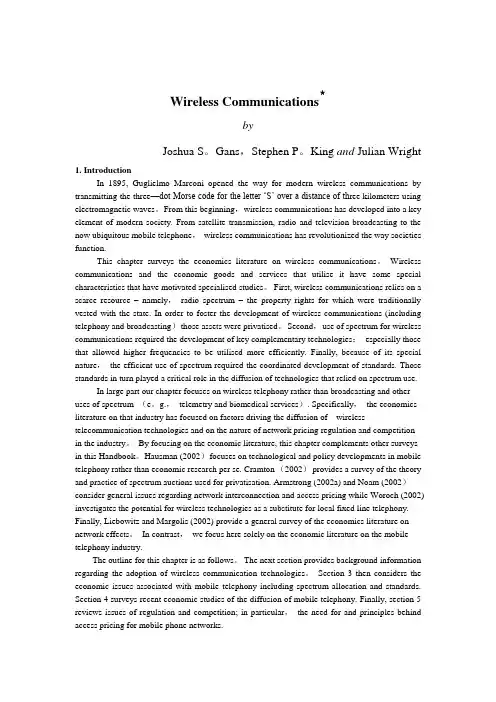
Wireless Communications*byJoshua S。
Gans,Stephen P。
King and Julian Wright1. IntroductionIn 1895, Guglielmo Marconi opened the way for modern wireless communications by transmitting the three—dot Morse code for the letter ‘S’ over a distance of th ree kilometers using electromagnetic waves。
From this beginning,wireless communications has developed into a key element of modern society. From satellite transmission, radio and television broadcasting to the now ubiquitous mobile telephone,wireless communications has revolutionized the way societies function.This chapter surveys the economics literature on wireless communications。
Wireless communications and the economic goods and services that utilise it have some special characteristics that have motivated specialised studies。
First, wireless communications relies on a scarce resource –namely,radio spectrum –the property rights for which were traditionally vested with the state. In order to foster the development of wireless communications (including telephony and broadcasting)those assets were privatised。
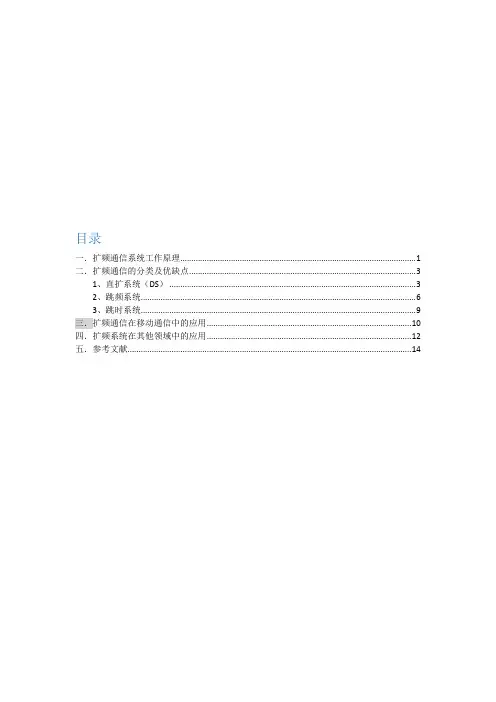
目录一.扩频通信系统工作原理 (1)二.扩频通信的分类及优缺点 (3)1、直扩系统(DS) (3)2、跳频系统 (6)3、跳时系统 (9)三.扩频通信在移动通信中的应用 (10)四.扩频系统在其他领域中的应用 (11)五.参考文献 (13)一.扩频通信系统工作原理长期以来,人们总是想法使信号所占领谱尽量的窄,以充分利用十分宝贵的频谱资源。
为什么要用这样宽频带的信号来传送信息呢?简单的回答就是主要为了通信的安全可靠。
扩频通信的基本特点,是传输信号所占用的频带宽度(W)远大于原始信息本身实际所需的最小(有效)带宽(DF),其比值称为处理增益Gp:Gp = W/DF (1)众所周知,任何信息的有效传输都需要一定的频率宽度,如话音为1.7 --- 3.1kHz,电视图像则宽到数兆赫。
为了充分利用有限的频率资源,增加通路数目,人们广泛选择不同调制方式,采用宽频信道(同轴电缆、微波和光纤等),和压缩频带等措施,同时力求使传输的媒介中传输的信号占用尽量窄的带宽。
因现今使用的电话、广播系统中,无论是采用调幅、调频或脉冲编码调制制式,Gp值一般都在十多倍范围内,统称为“窄带通信”。
而扩频通信的Gp值,高达数百、上千,称为“宽带通信”。
扩频通信的可行性,是从信息论和抗干扰理论的基本公式中引伸而来的。
信息论中关于信息容量的仙农(Shannon)公式为:C =WLog2(1十P/N) (2)式中:C --- 信道容量(用传输速率度量)W --- 信号频带宽度P --- 信号功率N --- 白噪声功率式(2)说明,在给定的传输速率C不变的条件下,频带宽度W和信噪比P/N是可以互换的。
即可通过增加频带宽度的方法,在较低的信噪比P/N(S/N)情况下,传输信息。
扩展频谱换取信噪比要求的降低,正是扩频通信的重要特点,并由此为扩频通信的应用奠定了基础。
扩频通信可行性的另一理论基础,为柯捷尔尼可夫关于信息传输差错概率的公式:Powj = f(E/N。
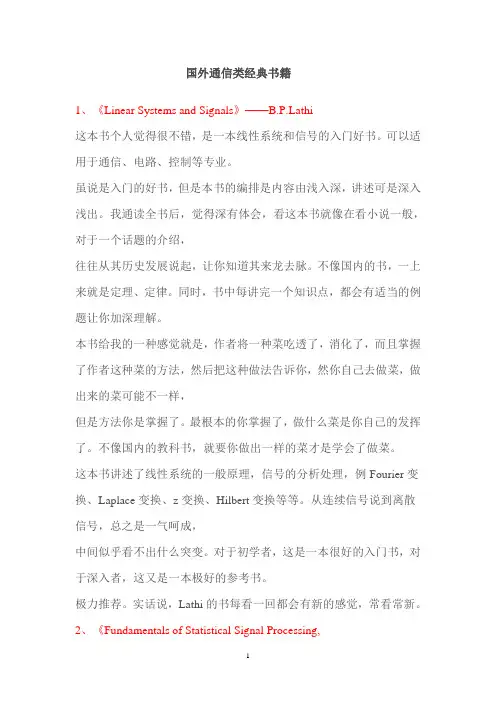
国外通信类经典书籍1、《Linear Systems and Signals》——thi这本书个人觉得很不错,是一本线性系统和信号的入门好书。
可以适用于通信、电路、控制等专业。
虽说是入门的好书,但是本书的编排是内容由浅入深,讲述可是深入浅出。
我通读全书后,觉得深有体会,看这本书就像在看小说一般,对于一个话题的介绍,往往从其历史发展说起,让你知道其来龙去脉。
不像国内的书,一上来就是定理、定律。
同时,书中每讲完一个知识点,都会有适当的例题让你加深理解。
本书给我的一种感觉就是,作者将一种菜吃透了,消化了,而且掌握了作者这种菜的方法,然后把这种做法告诉你,然你自己去做菜,做出来的菜可能不一样,但是方法你是掌握了。
最根本的你掌握了,做什么菜是你自己的发挥了。
不像国内的教科书,就要你做出一样的菜才是学会了做菜。
这本书讲述了线性系统的一般原理,信号的分析处理,例Fourier变换、Laplace变换、z变换、Hilbert变换等等。
从连续信号说到离散信号,总之是一气呵成,中间似乎看不出什么突变。
对于初学者,这是一本很好的入门书,对于深入者,这又是一本极好的参考书。
极力推荐。
实话说,Lathi的书每看一回都会有新的感觉,常看常新。
2、《Fundamentals of Statistical Signal Processing,Volume I: Estimation Theory》——Steven M. Kay3、《Fundamentals of Statistical Signal Processing,Volume II: Detection Theory》——Steven M. Kay这两本书是Kay的成名作。
我只读过第一卷,因为图书馆只有第一卷:p这两本书比Van Trees的书成书要晚,所以内容比较新。
作者的作风很严谨,书中的推导极其严密。
不失为一位严谨的学者的作风!虽说推导严密,但是本书也不只是单纯讲数学的,与工程应用也很贴近。
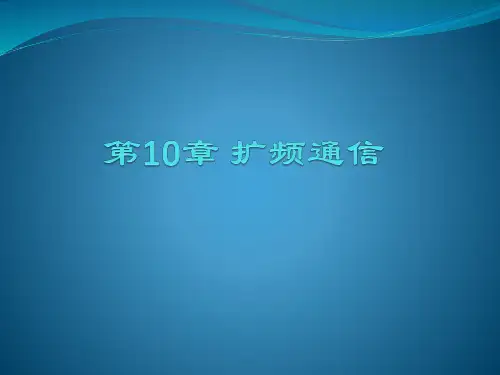

扩频通信原理扩频通信是一种利用扩频技术进行通信的方式,它通过将信号在较大的频带上进行传输,从而提高了通信系统的容量和抗干扰能力。
在扩频通信中,信号被调制成具有较大带宽的信号,然后再通过扩频码进行调制,最终在信道上传输。
扩频通信技术在军事通信、卫星通信、移动通信等领域有着广泛的应用。
扩频通信的原理主要包括信号调制、扩频码调制、信道传输和解调等几个方面。
首先,信号调制是将要传输的信息信号调制成具有较大带宽的信号,一般采用正交频分复用(OFDM)技术或者直接序列扩频(DSSS)技术。
接着,扩频码调制是将调制后的信号再通过扩频码进行调制,这个扩频码是一种伪随机序列,可以将信号的频谱扩展到较大的频带上。
然后,调制后的信号通过信道进行传输,这个信道可能会受到多径效应、多普勒频移等影响,因此需要采用合适的信道编解码技术来提高通信质量。
最后,接收端需要对传输过来的信号进行解调和解扩频,最终还原出原始的信息信号。
扩频通信的优点在于它具有较强的抗干扰能力和隐蔽性,因为扩频信号在频域上具有较大的带宽,使得它对窄带干扰信号具有很好的抑制作用。
此外,扩频码是一种伪随机序列,使得只有知道正确的扩频码才能够解扩频,因此具有较强的隐蔽性。
另外,扩频通信还可以实现多用户的同时通信,因为不同用户可以使用不同的扩频码来进行通信,从而提高了通信系统的容量。
然而,扩频通信也存在一些缺点,首先是它需要较大的带宽资源,这在一些频谱资源紧张的情况下会显得不太合适。
其次,扩频通信的系统复杂度较高,需要采用较复杂的调制解调器和编解码器,从而增加了系统的成本。
此外,由于扩频信号的带宽较大,使得其在功率和能耗上也会有所增加。
总的来说,扩频通信作为一种重要的通信技术,在现代通信系统中有着广泛的应用。
它通过利用扩频技术,提高了通信系统的容量和抗干扰能力,具有很好的隐蔽性和多用户接入能力。
随着通信技术的不断发展,相信扩频通信在未来会有更广阔的应用前景。
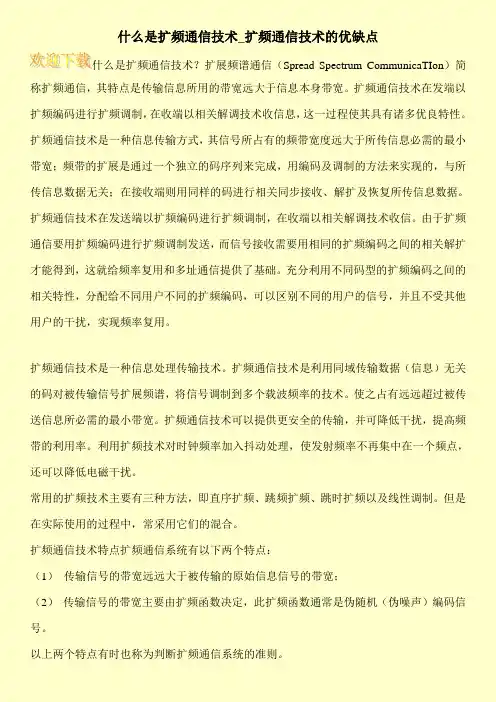
什么是扩频通信技术_扩频通信技术的优缺点什么是扩频通信技术?扩展频谱通信(Spread Spectrum CommunicaTIon)简称扩频通信,其特点是传输信息所用的带宽远大于信息本身带宽。
扩频通信技术在发端以扩频编码进行扩频调制,在收端以相关解调技术收信息,这一过程使其具有诸多优良特性。
扩频通信技术是一种信息传输方式,其信号所占有的频带宽度远大于所传信息必需的最小带宽;频带的扩展是通过一个独立的码序列来完成,用编码及调制的方法来实现的,与所传信息数据无关;在接收端则用同样的码进行相关同步接收、解扩及恢复所传信息数据。
扩频通信技术在发送端以扩频编码进行扩频调制,在收端以相关解调技术收信。
由于扩频通信要用扩频编码进行扩频调制发送,而信号接收需要用相同的扩频编码之间的相关解扩才能得到,这就给频率复用和多址通信提供了基础。
充分利用不同码型的扩频编码之间的相关特性,分配给不同用户不同的扩频编码,可以区别不同的用户的信号,并且不受其他用户的干扰,实现频率复用。
扩频通信技术是一种信息处理传输技术。
扩频通信技术是利用同域传输数据(信息)无关的码对被传输信号扩展频谱,将信号调制到多个载波频率的技术。
使之占有远远超过被传送信息所必需的最小带宽。
扩频通信技术可以提供更安全的传输,并可降低干扰,提高频带的利用率。
利用扩频技术对时钟频率加入抖动处理,使发射频率不再集中在一个频点,还可以降低电磁干扰。
常用的扩频技术主要有三种方法,即直序扩频、跳频扩频、跳时扩频以及线性调制。
但是在实际使用的过程中,常采用它们的混合。
扩频通信技术特点扩频通信系统有以下两个特点:(1)传输信号的带宽远远大于被传输的原始信息信号的带宽;(2)传输信号的带宽主要由扩频函数决定,此扩频函数通常是伪随机(伪噪声)编码信号。
以上两个特点有时也称为判断扩频通信系统的准则。
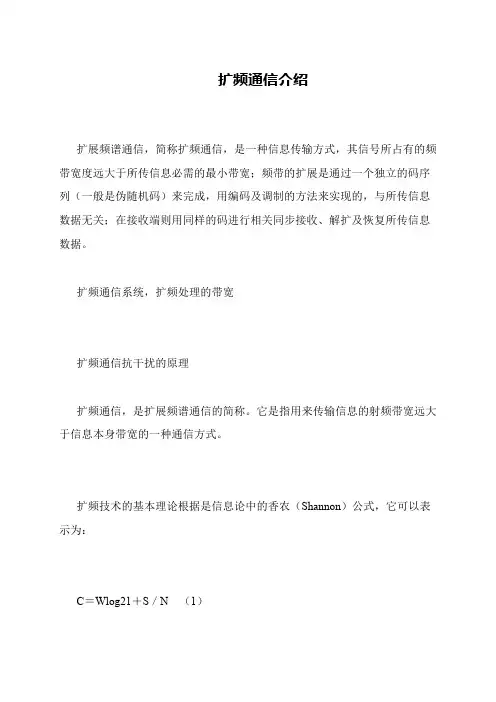
扩频通信介绍
扩展频谱通信,简称扩频通信,是一种信息传输方式,其信号所占有的频带宽度远大于所传信息必需的最小带宽;频带的扩展是通过一个独立的码序列(一般是伪随机码)来完成,用编码及调制的方法来实现的,与所传信息数据无关;在接收端则用同样的码进行相关同步接收、解扩及恢复所传信息数据。
扩频通信系统,扩频处理的带宽
扩频通信抗干扰的原理
扩频通信,是扩展频谱通信的简称。
它是指用来传输信息的射频带宽远大于信息本身带宽的一种通信方式。
扩频技术的基本理论根据是信息论中的香农(Shannon)公式,它可以表示为:
C=Wlog21+S/N (1)。
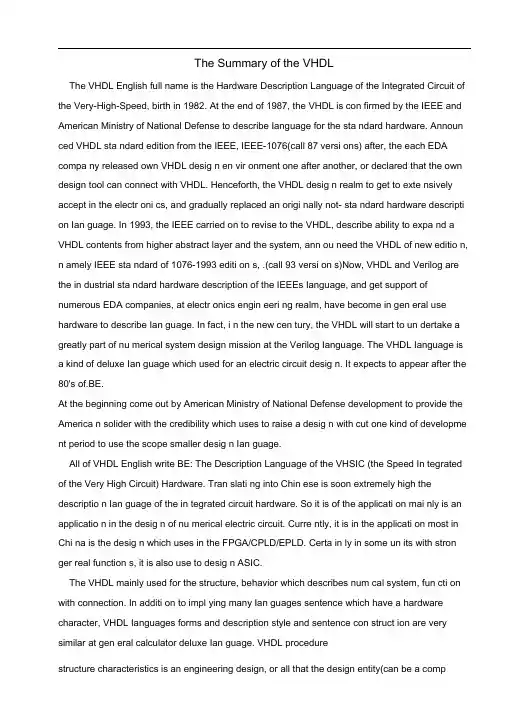
The Summary of the VHDLThe VHDL English full name is the Hardware Description Language of the Integrated Circuit of the Very-High-Speed, birth in 1982. At the end of 1987, the VHDL is con firmed by the IEEE and American Ministry of National Defense to describe Ianguage for the sta ndard hardware. Announ ced VHDL sta ndard edition from the IEEE, IEEE-1076(call 87 versi ons) after, the each EDA compa ny released own VHDL desig n en vir onment one after another, or declared that the own design tool can connect with VHDL. Henceforth, the VHDL desig n realm to get to exte nsively accept in the electr oni cs, and gradually replaced an origi nally not- sta ndard hardware descripti on Ian guage. In 1993, the IEEE carried on to revise to the VHDL, describe ability to expa nd a VHDL contents from higher abstract layer and the system, ann ou need the VHDL of new editio n, n amely IEEE sta ndard of 1076-1993 editi on s, .(call 93 versi on s)Now, VHDL and Verilog are the in dustrial sta ndard hardware description of the IEEEs Ianguage, and get support of numerous EDA companies, at electr onics engin eeri ng realm, have become in gen eral use hardware to describe Ian guage. In fact, i n the new cen tury, the VHDL will start to un dertake a greatly part of nu merical system design mission at the Verilog Ianguage. The VHDL Ianguage is a kind of deluxe Ian guage which used for an electric circuit desig n. It expects to appear after the 80's of.BE.At the beginning come out by American Ministry of National Defense development to provide the America n solider with the credibility which uses to raise a desig n with cut one kind of developme nt period to use the scope smaller desig n Ian guage.All of VHDL English write BE: The Description Language of the VHSIC (the Speed In tegrated of the Very High Circuit) Hardware. Tran slati ng into Chin ese is soon extremely high the descriptio n Ian guage of the in tegrated circuit hardware. So it is of the applicati on mai nly is an applicatio n in the desig n of nu merical electric circuit. Curre ntly, it is in the applicati on most in Chi na is the desig n which uses in the FPGA/CPLD/EPLD. Certa in ly in some un its with stron ger real function s, it is also use to desig n ASIC.The VHDL mainly used for the structure, behavior which describes num cal system, fun cti on with connection. In additi on to impl ying many Ian guages sentence which have a hardware character, VHDL Ianguages forms and description style and sentence con struct ion are very similar at gen eral calculator deluxe Ian guage. VHDL procedurestructure characteristics is an engineering design, or all that the design entity(can be a component, an electric circuit mold piece or a system) is divided into exterior(or call but part, and port) with inner part(or call to can't see part), since invo Ive internal function and calculate way of en tity to complete part. At one desig ned en tity to defi ne exterior in terface after, once it internaldevelopme nt completi on after, other desig ns can directly adjust touse this en tity. This ki nd of desig n will en tity to be divided in to a little bit basic VHDL system that is a VHDL system in side the con cept of outside part desig n of a little bit basic and other hardware describe the Ianguage compare and the VHDL has a following characters: The function is strong and the design be vivid. The VHDL has the function strong Ianguage structure, can describe a complicated logic control with the simple and direct and explicit source code. It has a multi-layer desig n descripti on fun cti on, in multiple layers thi n turn, fin ally directly born electric circuit class descripti on. The VHDL supports synchronous electric circuit, differenee's tread electric circuit with random the design of electric circuit, this be the other hardware descripti on although the Ian guage can't compare to. The VHDL still supports various desig n method, since support from the bottom upward desig n, support aga in from the desig n of crest declivity; since the support mold piece tur ns a design, support layer's turn a design again. Support extensively and be easy to a modificatio n. Because the VHDL has already become IEEE sta ndard the norm of hardware description Ianguage, most EDA tools almost support VHDL currently, this is VHDL of further expansion with extensively applied lay foundation. In the design process of the hardware electric circuit, the mai n desig n docume nt is the source code which writes with the VHDL, the VHDL easily reads with the structure turn, so be easy to a modification desig n.The strong system hardware describes ability. The VHDL has a multi-layer design description function, since can describe system class electric circuit, can describe door class electric circuit again. And description can adopt a behavior description, deposit a machine to deliver description or structure description, can also adopt the hybrid descripti on of threes mixture. Moreover, VHDL support is in ertial to delay and deliver to delay, can also accurately build up hardware electric circuit model. VHDL support prepare defi nite of with from defi niti on of data type, bring hardware descripti on a bigger freedom degree, make desig n the pers onnel can expedie ntly establish the system model of high time.The in depe ndence is at the desig n of spare part, have nothing to do with the craft. Don'tneed to consider a choice completion the spare part of design first while designing a pers onnel to carry on a desig n with the VHDL, can concen trate en ergy to carry on desig n of excelle nt tur n.When the desig n descripti on complete after, can carry out its fun cti on with various different spare part structure very strong transplantation ability. The VHDL is a kind of hardware descripti on for sta ndardize Ian guage, the same of desig n descripti on can be support by the differe nt tool and make to desig n to describe of the tran spla ntati on make possible.Be easy to share and reply to use. The VHDL adopti on can build up various mold piece that can again make use of according to the design method of database (Library). These canned in advanee design or use to design a medium backup mold a piece before and depositted these to the database in, can be in lately of the desig n carry on replyi ng to use, can make the design result be design the personnel's to carry on exchanges and share, decrease hardware electric circuit desig n.("Compared with other hardware description Ianguages, the VHDL have stronger behavior descriptio n on ability, come to a decisi on him to become a system desig n realm the best hardware a descriptio n Ian guage thus. The strong behavior descripti on ability is to avert from con crete spare part structure and describe and desig n importa nt assura nee of large-scale electr onics system from the logic behavior.(2) The VHDL be abundant of imitate true Ian guage sentence and database fun cti on, make in any big system of the desig n can in spect a function possibility of desig n the system in early days, can carry on imitati ng true emulati on to the desig n at any time.(3) The ability and procedure structure of the behavior descripti on with lexical VHDL come to a decisi on the decompositi on that he has to support a large-scale desig n with have already have desig n of aga in make use of fun cti on. Meet the market dema nding large-scale system efficie ntly, the completi on of the high speed has to in clude many people the several gen erati on hair set eve n together and abreast works and the n can carry out.(4) For use the desig n of an assura nee of VHDL completi on, can make use of EDA toolto carry on logic comprehensive with excellent turn, and auto of the VHDL describe the desig n cha nge into the door class net form.(5)The descripti on of VHDL to desig n have opposite and in depe ndent, the desig n can not un dersta nd the structure of hardware and n eed not man age the target spare part that the end desig n carry out, either is what, but carry on an in depe ndent desig n.VHDL 的介绍VHDL 的英文全名是Very-High-Speed In tegrated Circuit Hardware Description Language,诞生于1982年。
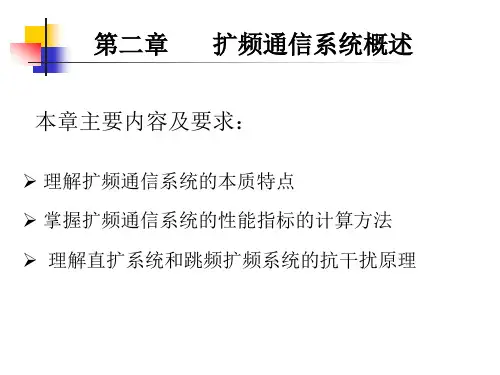

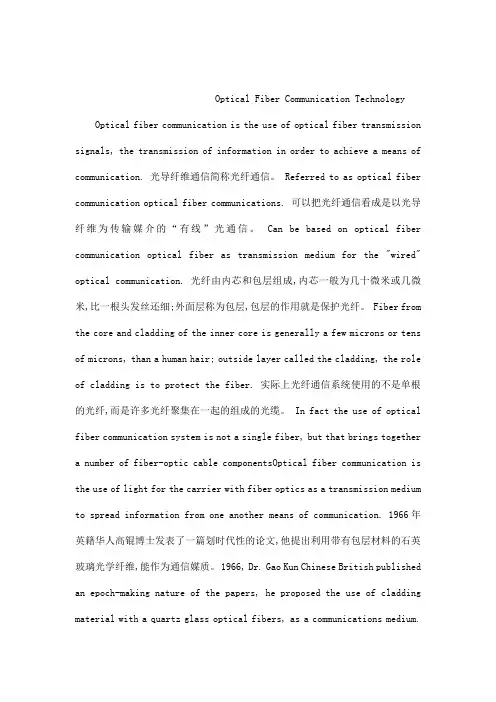
Optical Fiber Communication TechnologyOptical fiber communication is the use of optical fiber transmission signals, the transmission of information in order to achieve a means of communication. 光导纤维通信简称光纤通信。
Referred to as optical fiber communication optical fiber communications. 可以把光纤通信看成是以光导纤维为传输媒介的“有线”光通信。
Can be based on optical fiber communication optical fiber as transmission medium for the "wired" optical communication. 光纤由内芯和包层组成,内芯一般为几十微米或几微米,比一根头发丝还细;外面层称为包层,包层的作用就是保护光纤。
Fiber from the core and cladding of the inner core is generally a few microns or tens of microns, than a human hair; outside layer called the cladding, the role of cladding is to protect the fiber. 实际上光纤通信系统使用的不是单根的光纤,而是许多光纤聚集在一起的组成的光缆。
In fact the use of optical fiber communication system is not a single fiber, but that brings together a number of fiber-optic cable componentsOptical fiber communication is the use of light for the carrier with fiber optics as a transmission medium to spread information from one another means of communication. 1966年英籍华人高锟博士发表了一篇划时代性的论文,他提出利用带有包层材料的石英玻璃光学纤维,能作为通信媒质。
Uint1抽样量化和编码:sampling quantizing and coding话路:speech channel幅值:amplitude value抽样频率:sampling frequency抽样速率:sampling speed rate脉冲流:stream of pulses重复率: repetition rate编码过程:coding processs模拟信号:analog signal传输质量transmission quality数字通信digital communication数字传输digital transmission含噪声的环境noisy environment传输路由transmission path信号比signal-to-noise ratio信号电平signal levels地面系统terrestrial system噪声功率noise power二进制传输binary transmission反向操作reverse operation8位码序列8-digit sequence接收端receiving terminal帧格式frame format同步字synchronization wordthe schemes for performing these three function 实现这三项功能的方案a series of amplitude values 一串幅值a speech channel of telephone quality 电话质量的话路a sequence of 8-binary digits 一个8位二进制码的序列a minimum theoretical sampling frequency 理论上的最小抽样频率a voice channel occupying the range 300Hz to 3.4KHz 占据着300Hz到3.4KHz 频率范围的话路8-digits per sample value 每个样值8位码the sparking of a car ignition system 汽车点火系统的大火the stream of the pulsese with a repetition rate of 64KHz 重复率为64KHz的脉冲the relationship of the true signal to the noise signal 真实信号与噪声信号的关系the signal received from a satellite 由卫星上收到的信号the complete information about a particular message 一条特定消息的全部信息the shape of the transmitted signal 被传信号的波形the attenuation introduced by transmission path 由传输路由引入的衰减the unit that converts sampled amplitude value to a set of pulses 将抽样的幅值转换成一串脉冲的单元a sequence relating to channel 1,2 and son on涉及到第一路、第二路及其他各路的序列a unique sequence of pulses called synchronizationword 被称为同步字的独特的码序列terrestrial system 地面系统the presence or absence of the pulse 脉冲的“有”或“无”a high-speed electronic switch 高速的电子开关the time division multiplexer 时分多路复用器Time Division Multiplexing 时分多路复用Unit2串行接口 serial interface显示终端 CRT terminal发送器与接收器 transmitter and receiver数据传输 data transmission数据流 data stream闲置状态the idle state传号电平 mark level空号电平 space level起始位start bit停止位stop bitT秒的持续时间duration of T seconds奇偶校验位parity bit错误标志error flag传输错误transmission error下降沿falling edge符号间的空格 intersymbol space接收机的定时 receiver timing本地时钟local clock磁带 magnetic tape控制比特 control bit逻辑1电平logical 1 level二进制数据binary data明显的缺点obvious disadvantageasynchronous serial data transmission 异步串行数据传输The most popular serial interface 最为流行的串行接口The transmitted data 所传送的数据The clocks at the transmitter and receiver发送器和接收器的时钟The era of teleprinter电传机的时代The dots and dashes of a character一个字符的点和划Three times the duration of intersymbol space符号间空格持续时间的三倍The group of bits called characters 被称为字符的比特组The invariable units comprising 7 or 8 bits ofinformation由7或8个比特的信息组成的固定单元A clock generated locally by the receiver 由接收机本地产生的时钟The received parity bit following the character 在字符后所收到的奇偶校验位The falling edge of the start bit 起始位的下降沿The character-oriented nature of the data link 数据链路面向字符的特性Uint3联网技术 networking technology国际标准化组织 international Organization forStandardization (ISO)参考模型 reference model数据分组 packet data应用程序 application program网络媒体 network media分层 called layering硬件和软件 hardware and software表示层 the presentation layer传输层 the transport layer数据链路层 the data link layer网络服务 network services文件接入 file access数据格式 data format主机 host协议 protocol连接 connectivity逻辑地址 logical addressingNetworking technology 联网技术Proprietary networking system 专用联网系统The international Organization for Standardization国际标准规划组织Compatibility between the various type of networks各种网络之间的兼容性Seven numbered layers 七层协议Standardization of network components 网络部件的标准化Error recovery 纠错Receiving host’s system 发方主机系统Connection-oriented circuits 面向连接的电路Information flow control 信息流控制Network media access 网络媒体接入Electrical specification 电气特性Maximum transmission distance 最大传输距离Uint 4传输控制协议transmission control protocol互联协议Internet protocol数据通信data communication微波microwave高层协议higher-level protocol流量控制traffic control目的地destination(信)源resource段segment互联层Internet layer分组交换packet switching超文本传输协议hypertext transfer protocol灵活性flexibility数据报datagramtransmission control protocol传输控制协议Internet protocol互联协议satellite links卫星链路the Standard On which the internet has grown互联网发展所基于的标准Network access layer网络接人层connection-oriented protocol面向连接的协议file transfer protocol文件传输协议hypertext transfer protocol超文本传输协议domain name system域名系统developer of software软件开发人user datagram protocol用户数据报协议packet -switched technology分组交换技术Unit 5局域网local area network工作站workstation外设peripheral拓扑topology集线器hub交换器switch流量traffic网络接口卡network interface card数据库database印刷电路板printed circuit board主板motherboard网络适配器network adaptor并行数据parallel data电脉冲electrical impulses中继器repeater联网介质networking medialocal-area network局域网logical topology逻辑拓扑devices that connect directly to a network segment 直接连到网络段的部件network interface card网络接口卡process of the encapsulation打包的过程standardized symbol标准化的符号printed circuit board印刷电路板expansion slot of a bus on a computer’s motherboard 在计算机母板上总线的扩展槽network adapter网络适配器parallel signal produced by the computer由计算机产生的并行信号transmltting station发送站the specifications for Category 5 twisted-pair Ethernet五类双绞线以太网的规范Unit 6无源集线器passive hub网桥 bridge可用带宽 useable handwidth地址表addressing table交换器 switch路由器 router光纤optical fiber无线介质wireless media铜线copper wirethe device that serves as the center of network作为网络中心的部件multi-port repeater多端口中继器reliability of the network网络的可靠性passive or active hubs无源或有源的集线器protocol address or network address地址或网络地址network administrator网络管理者switching of packets to the best route交换分组到最佳路由network segment网络段Unit 7网络资源network resource信息服务information services远程终端remote terminals地址address互连的系统 interconnected systems命令 command电子邮件electronic mail主机Host无线信道wireless channels搜索工具popup用户界面user interface拷贝copy'互连网popup存取access文本信息textual messages鼠标mouse协议protocol超文本协议hypertext protocolgiant network of computers located all over theworld分布在全世界的计算机的巨大网络backbone system主干系统nationwide network全国范围的网络electronic conferences电子会议remote terminal远程终端live conversation实时的对话world wide web万维网searching tool搜寻工具the largest repository of information 最大的信息库network facilities resources网络设备资源the vast majority of the computers on the net在网上的绝大多数计算机the Unix operating system UNIX操作系统textual message文本信息sa way to move data between the internet and your PC在因特网和你的PC机之间传送数据的方法the convenient searching tools方便的搜索工具the networked hypertext protocol 联网的超文本协议Unit 8optical fiber communications 光纤通信light source 光源wavelength 波长laser 激光器dispersion 色散transmission medium传输介质multi-mode fiber 多模光纤long-haul trunks 长途干线single-mode fiber 单模光纤bandwidth 带宽wideband subscriber 宽带用户fiber-optics 纤维光学commercial technology 商用技术threshold current 门限电流photodetector 光检测器wavelength multiplexing 波分复用fiber-optic networks 纤维光网络video bandwidth 视频带宽长途传输 long distance transmission中继距离. repeater spacing商用技术 . commercial technology<光纤通信 . optical fibre communications已装光纤的总长度 . the total length of installedfibre长途通信系统 long-haul telecommunication system低衰减的石英纤维 the low-loss silica fibre衰减逼近瑞利极限的光纤fibers with lossesapproaching the Rayleigh limit室温下的门限电流 . room temperature thresholdcurrents较长波长区the longer wavelength region用户接入工程. subscriber access project部件性能和可靠性的改进improvements in componentperformance and reliability<已安装的光纤系统的数据速率data rates forinstalled fibre optic system每秒吉比特gigabit per second range波分复用. wavelength multiplexing宽带用户环路系统. wideband subscriber loop system多纤连接器. multifibre connectors设计寿命 . projected lifetime光源. light source单模光纤. single-mode fibre分布反馈式激光器 distributed-feedback laser信息容量 information capacity交换体系. switching hierarchy宽带业务 .broadband servicesUnit 9cellular mobile telephone 蜂窝式移动电话service perfor mance 服务性能frequency band 频带microprocessor 微处理器mobile unit 移动手机broadcast service广播业务antenna 天线subsystems 子系统mobile subscriber 移动用户service capability 服务能力untiliaztion 利用率bandwidth 带宽single-sideband 单边带spread spectrum 扩频large scale integrated circuits 大规模集成电路cellular site 蜂窝点cellular switch 蜂窝交换机radio cabinet 无线机架call processing 呼叫处理service area 服务区frequency spectrum untiliaztion 频谱利用率the limited assigned frequency band 有限的指定频带complicated features and functions 复杂的特性和功能large-scale integrated circuit technology 大规模集成电路技术developmental cellular system 实验性的蜂窝系统central coordinating element 中央协调单元cellular administration 蜂窝管理operational limitation of conventional mobile telephone system 传统移动电话的运行限制limited service capability 有限的服务能力radio communication industry 无线通行行业available radio frequency spectrum 可用的无线电频谱the allocated frequency band 所分配的频带mobile transceiver 移动收发器technological feasibility 技术上的可行性servere spectrum limitation 严厉的频谱限制FM broadcasting service 调频广播业务propagation path loss 传播路径衰耗multipath fading 多路径衰耗telephone company zone officee 电话公司地方局unit 10personal communications 个人通信communication standards 通信标准fixed telephone service 固定电话业务network capacity 网络容量mobile switching center 移动交换中心international roaming 国际漫游broadband services 宽带业务interface converseon 接口转换frequency allocation 频谱分配analogue mode 模拟方式cellular communication principle 蜂窝通信原理jamming 拥塞cell splitting 蜂窝裂变base station 基站register 寄存器billing function 收费功能access method 接入方法burst transmission mode 突发脉冲传输方式overhead information 开销信息handover algorithms 切换算法short message sevice 短消息服务technical specification 技术规范total acess communication system 全接入的通信系统global mobile communication system 全球移动通信系统time division multiple acess 时分多址facsimile and short message service 传真和短消息服务fixed communicateon networks 固定通信网络a more personalized system 更个人化的系统the cost and quality of the link 链路的价格与质量marker growth 市场的发展coaxial cable 同轴电缆frequency reuse and cll splitting 频率再生和蜂窝裂变cochannel interference 共信道干扰theroretical spectral capability 理论上的频谱容量micro-cellular system 微蜂窝系统base station transceiver 基站收发器subscriber register 用户寄存器advanced handover algorithms 先进的切换算法the GSM technicall specifications GSM的技术规范unit 11circuit switching 电路交换packet switching 分组交换message switching 报文交换subnet 子网header 信头destination address 目的地error control误差控制store-and-forward manner 存储转发方式bursty 突发性transmission delay 传输时延intermediate switching equipment 中间交换设备switching technique 交换技术return signal 返回信号message processor 报文处理机given maximum length 给定最大长度information transfer 信息转移random 随机性dedicated circuit 专用电路channel utilization 电路利用率the capability of storing and manipulating user’sdata 存储和处理用户的能力the special signaling message 特定的信令信息a well defined block of data called a message 被精心定义的称为报文的数据块the information regarding the source anddestination addersses 涉及源和目的地址的信息the computer referred to as a message processor 叫做报文处理器的计算机the store-and-forward transmission technique 存储转发传输技术the dynamic allocation of the bandwidth 带宽的动态分配the overall transmission delay of the message报文整个的传输时延switching technique 交换技术total path of connected lines 连线的整个通路source-destination pair 源到目的地的一对communication parties 通信各方transmission unit 传输单元initial connection cost incurred in setting up thecircuit 在建立电路时产生的起初连接成本low delay constraint requited by the user 用户所需的短时延的限制the fixed dedicated end-to-end circuit 固定专用的端到端电路low channel utilization 低的电路利用率unit 12asynchronous transfer mode 异步转移模式logical channel 逻辑信道virtual circuits 虚电路virtual paths 虚路径recommendation 建议network level 网络层service and application level 业务和应用层virtual connection 虚连接information superhighway 信息高速公路vedio-on-demand 点播电视statistical multiplexing 统计复用digital information 数字化的信息identifier 标识符protocols 协议network node 网络节点broadband network 宽带网ATM forum ATM论坛future-proofed 面向未来的image encoding 图像编码virtual private network 虚拟专用网data processing 数据处理short packets called cells 被叫做信元的短的分组bit rates of several hundred megabits a second 每秒几百兆比特的速率unique multiplexing method 独特的复用方法the physical connection between any to terminals 任何两个终端之间的物理连接interactive video services 交互式的视频业务a nature vehicle for multimedia services 多媒体业务的自然载体the crrent and future requirements of both operators and users 运营者和用户当前和未来的要求the technique for switching high bit rate channel 高比特率信道的交换技术multiplexing and switching technique 复用和交换技术the underlying type of transmission 所承载的传输类型dual identification 双重标识the transfer of cells to the network nodes 信元在网络节点上的转移hundreds megabits a second 每秒几百兆比特recommendation I.121 I.121建议the quality of service 业务质量in proportion to the exact requirement 与实际需求成比例the application and service transported over a network 网络所传送的应用和业务the ability to construct virtual network 构成虚网络的能力cost-effiective use of infrastructure 低价高效的利用网络设施coordinating different networks carrying different services 协调传送不同业务的不同网络essential components of future information superhighways 未来的信息高速公路的基本部件optimum use of resource 资源的最佳使用unit 13public telecommunication network 公众电信网local loop 本地环路switching node 交换节点twisted pair 双绞线external call 外部呼叫end office 端局digital data system 数字数据系统two wire connection 二线连接toll center 收费中心circuit-switched network 电路交换网telephone subscriber 电话用户data traffic 数据流量link 链路trunk 中继线half-duplex 半双工full-duplex 全双工voice-frequency circuit 音频电路trandem switch 汇接交换机topology 拓扑internode 节点间的route 路由full-duplex connection 全双工的连接the function of concentrating traffic 集中话务量的功能the switching nodes called tandem seitches 被称为汇接局的交换节点a fraction of subscriber 一小部分用户the interface between the station and the network在站和网络之间的接口the subscriber that transmit digital signal 发送数字信号的用户national networks 国家网络architectural components 结构部件the branches between nodes 节点间的支路tree topology 树状拓扑transmission facilities 传输设备multiple voice-frequency circuit 多条音频电路synchronous TDM 同步时分复用adjacent end offices 相邻的端局full connectivity 全连通性isolated subnetworks 被分离的子网high usage trunks 高效中继线basic order of selection 路由选择的基本次序backbone hierarchical network 主干体系网络two subscribers attached to different end offices连接到不同端局的两个用户exchange area 交换区Unit 14global communications 全球通信flexibility 灵活性end-to-end digital connectivity 端到端的数字连接open network 开放网络voice encoding 语音编码integrated services digital network综合业务数字网infrastructure 系统结构International Organization for Standardization 国际标准化组织communication carriers 通信载体transmission medium 传输媒体interface equipment 接口设备bandwidth limitation 带宽限制switching equipment 交换设备pulse code modulation 脉冲调制basic access 基本接入degradation due to the transmission medium 由于传输媒体导致的质量下降bandwidth limitations inherent in a 4 kHz voicechannel 4 kHz 路中所固有的带宽限制standardized ports 标准化的接口pulse code modulation 脉冲编码调制digital communication 数字通信ISDN standards and system architecture ISDN的标准和系统结构progressive application of digital technology 数字技术的逐步应用public communication carriers 公共通信载体enhanced quality 高质量substantial quantity of interface equipment 大量的接口设备flexibility in the transmission ofvoice ,data ,video and other services 在传送话音、数据、视频和其他业务上的灵活性voice encoding techniques 语音编码技术pulse coding modulation脉冲编码调制basic access signaling rate 基本接入信令速率universal access 统一的接入experimental technology 实验性的技术unit 15X.25 protocol X.25 协议television signals 电视信号narrowband services 窄带业务basic access 基本接入teleservice 电信业务telex 用户电报radio waves 无线电波ground antenna 地面天线coaxial 同轴的direct broadcast system 直接广播系统end-to-end delay 端到端的时延jitter 抖动peak hours 繁忙小时chip technology 芯片技术high definition television 高清晰度电视operations and maintenance 运行与维护the existing public network 现有的公用网络classical two-way voice conversation 传统的双向对话packet switched data network based on X.25 protocols基于X.25协议的分组交换数据网络the user access to the network 对网络用户接入a circuit switched service with a channel rate of70 Mbit/s 信道速率为70 Mbit/s的电路交换业务the service-independent network 与业务无关的网络the optimal statistical sharing of the resources对资源的最佳统计共享telecommunication service 电信业务telex network 用户电报网messages of characters 文字报two-way voice conversation 双向对话X.21 protocols X.21协议coaxial tree network 同轴数状网络community antenna TV network 公用天线的电视网络direct broadcast system 直接广播系统Ethernet 以太网token bus and token ring network 令牌总线网和令牌环网word-wide independent networks 全球范围的独立网络resource pooling 资源共享peak hour traffic 繁忙小时流量integration of narrow-band services窄带业务的综合the progress in speech coding and chip technology 在语声编码和芯片技术方面的进步a new teleservice 新的电信业务adapting to new service requirements对新业务要求的适配optimal statistical sharing of the resources 资源最佳统计式的共享。
扩频通信技术的应用电信09-1李媛媛16号扩频通信,即扩展频谱通信(Spread Spectrum Communication)的简称,它是指用来传输信息的射频信号带宽远远大于信息本身带宽的一种通信方式。
扩频技术最大的特点是利用宽频带来传输信号。
由于扩频系统具有许多优点,如抗干扰能力强、截获概率低和保密性强以及良好的码分多址通信能力,所以扩频技术已被广泛应用。
CDMA数字蜂窝移动通信等,就是利用扩频技术发展起来的一种扩频通信方式,它具有容量大,通信质量好,节约发射功率等优点。
我主要就一些扩频通信的原理及在CDMA中的应用作了一些了解。
一、扩频通信的理论基础扩频通信系统的模型:香农公式:C = W×Log2(1+S/N)式中:C--信息的传输速率 S--有用信号功率 W--频带宽度 N--噪声功率由式中可以看出:为了提高信息的传输速率C,可以从两种途径实现,既加大带宽W或提高信噪比S/N。
换句话说,当信号的传输速率C一定时,信号带宽W和信噪比S/N 是可以互换的,即增加信号带宽可以降低对信噪比的要求,当带宽增加到一定程度,允许信噪比进一步降低,有用信号功率接近噪声功率甚至淹没在噪声之下也是可能的。
扩频通信就是用宽带传输技术来换取信噪比上的好处,这就是扩频通信的基本思想和理论依据。
按照扩展频谱的方式不同,现有的扩频通信系统可以分为以下几种:1.直接序列扩频工作方式,简称直扩(DS)方式所谓直接序列(DS,Direct Sequency)扩频,就是直接用具有高码率的扩频码序列在发端去扩展信号的频谱。
而在收端,用相同的扩频码序列去进行解扩,把展宽的扩频信号还原成原始的信息。
2.跳变频率工作方式,简称调频(FH)方式所谓跳频,比较确切的意思是用一定码序列进行选择的多频率频移键控。
也就是说,用扩频码序列去进行频移键控调制,使载波频率不断地跳变,所以称为跳频。
3.跳变时间工作方式,简称跳时(TH)方式与跳频相似,跳时(TH,Time Hopping)是使发射信号在时间轴上跳变。
计算机与因特网插件指南Life on-line can be a much richer experience when you aren't restricted to just written words and still pictures. Even if you're new to the Net, you've probably heard aobut multimedia on-line--listening to audio, watching animations and videos, even playing in three-dimensional space. Sound and movement make information come alive.To experience it, you'll need special pieces of software called plug-ins. The term "plug-in" refers to a small, add-on piece of software which extends the capabilities of your web browser, like Netscape Navigator or Microsoft Explorer, turning your computer into a radio or TV.When you arrive at a web page which contains a file requiring a plug-in which you don't have, you will usually receive a message asking if you want to get it by downloading it and installing it into your computer. Most of the time, the installation will be automatic.Occasionally, you'll run into a downloaded file which needs to be decompressed or un-zipped before installation. Once installed, plug-ins run automatically, without you having to do anything.Many multimedia controls still need to be obtained from the developer but are installed automatically.Shockwave is a good example of this. All you need to do is go to the Macromedia site and click on the link to install the ActiveX control. The rest happens automatically. The next time you go to a "Shocked" website, the Shockwave control loads and plays the movie.Most plug-ins and controls can be downloaded for free on the Internet, although not all will work with every system. Some of them, for instance, only work with windows95.当你不再仅仅限于文字和静止图片时,网上生活会丰富多彩得多。
外文出处:/en/app-notes/index.mvp/id/1890/扩频通信系统的介绍一、扩频通信的原理扩频是香农定理的典型:C=B×log2(1+S/N) 公式(1)在公式中,C为信道容限,单位是比特/秒(bps),意指单位时间内信道中无差错传输的最大信息量。
B为信号频带宽度,单位是Hz,S/N为信噪比。
也就是说,C为信道允许通过的信息量,也代表了扩频的性能。
带宽(B)是代价,因为频率是一个有限的资源。
信噪比体现了环境条件或物理特性(如障碍、干扰器、干扰等)。
上式说明,的情况下,在无差错传输的信息速率C不变时,如果信噪比很低,则可以用足够宽的带宽来传输信号,即使信号功率密度低于噪音水平。
(公式可用!)改变公式(1)中对数的底数,2改为e,则为In=loge。
因此,C/B=(1/ln2)×ln(1+S/N)=1.443×ln(1+S/N)公式(2)根据MacLaurin扩展公式ln(1+x)=x-x2/2+x3/3-x4/4+…+(-1)k+1xk/k+…:C/B=1.443×(S/N-1/2×(S/N)2+1/3×(S/N)3-…) 公式(3)在扩频应用中,通常S/N很低。
(正如刚才提到的,信号功率密度甚至低于噪音水平。
)假定噪音水平即S/N<<1,香农公式可简单表示为:C/B≈1.443×S/N公式(4)简化为:C/N≈S/N 公式(5)或者:N/S≈B/C 公式(6)向固定了信噪比的信道发送错误的信息,只要执行基本扩频信号的传播操作:增加传输带宽。
尽管这一原则看起来很简单明确,但实现她却很复杂,主要是因为展宽基带的电子设备必须同时存在展宽和解扩的操作过程。
二、定义不同的扩频技术都有一个共同之处:密钥(也称为代码或序列)依附于传输信道。
以插入代码的形式准确地定义扩频技术,术语“频谱扩展”是指扩频信号的几个数量级的带宽在有密钥的传输信道中的扩展。
以传统的方式定义扩频更为精确:在射频通信系统中,将基带信号扩展为比原有信号的带宽宽得多的高频信号(如图1)。
在此过程中,传输宽带信号产生的损耗,表现为噪声。
扩频信号带宽与信息带宽之比称为处理增益。
扩频过程的处理增益大都在10dB 到60dB 之间。
要应用扩频技术,只需在天线(接收器)之前加入相应的扩频码。
相反,你可以删除一个点的扩频码(称为解扩操作)接收发射链路数据恢复。
解扩过程是重新恢复原始带宽的过程。
很明显,同样的代码必须在事先知道在传输通道两端的信息。
(在某些情况下,在调制和解调的过程中代码应该是知道的)。
图1.扩频通信系统扩频的优点抗干扰性能和抗干扰的影响扩频技术有很多优点。
.抗干扰性是最重要的一个优点。
有意或无意的干扰和干扰信号都是不希望存在的因为它们不包含扩频密钥。
只有期望信号才有密钥,在解扩过程中才会被接收器接收,如图5。
图5.扩频通信系统。
注意,解扩链路中数据信号被传输的同时干扰能源也被传输。
无论在窄带或宽带中,如果它不涉及解扩过程,你几乎可以忽略干扰。
这种抑制反应输电链 扩频代码 接收链扩频代码数据输入射频输出射频输入 射频连接 数据输出数据 干扰 数据扩展和干扰扩展数据扩展 数据扩展和干扰 输电链 扩频代码接收链扩频代码数据输入射频输出射频输入 射频连接 相同的配置序列 数据输出也适用于其他没有正确密钥的扩频信号。
因此不同的扩频通信系统可以工作在同一频段,例如CDMA 。
值得注意的是,扩频是宽带技术,但反之则不然:宽带技术不涉及扩频技术。
抗截获抗截获是扩频通信技术的第二个优势。
由于非法的听众没有密钥用于原始信号传播,这些听众无法解码。
没有合适的钥匙,扩频信号会出现噪音或干扰。
(扫描方法可以打破的这些密钥,但是密钥是短暂的。
)甚至更好,信号电平可以低于噪声水平,因为扩频传输降低了频谱密度,如图6。
(总能量是相同的,但它是广泛存在于频率的。
)因此信息是无形的,这一影响在直接序列扩频(DSSS )技术上有充分的体现。
(在下文的DSSS 作更详细说明。
)其他接收机无法“看到”这种传输,它们只能出现在整体噪音水平略有增加的情况下!图6.在被噪音水平之下的扩频频谱信号。
在没有正确的扩频传输密钥的情况下,接收器不能“看到”传输过程。
抗衰落(多径效应)无线信道通常具有多径传播,即有一个以上的信号从发射机传到接收器(如图7)。
这种多路径可以通过空气的反射或折射以及从地面反射或物体如这些路径建筑物引起。
图7.信号是如何通过多个路径到达接收器的。
这种反射路径(R )可干扰直接路径(D )的现象称为解扩过程的同步衰落。
因为解扩过程使信号D 与信号R 的同步被拒绝,即使它们包含了相同的密钥。
将反射路径的信号应用于解扩是个有用的方法。
扩频技术在CDMA 的应用请注意,扩展频谱不是一个扩频调制方案,不应与其他调制方式相混淆。
例如我们可以使用扩频技术发射一个由PSK 或BPSK 的已调信号。
.感谢调制的信号的编码基础,使扩频频谱也可用于其他类型的多址实现(即可以同时进行多个通讯联系和实际或表面上相RxRDTx 噪声基准 扩展后的数据噪声基准数据传播之前同的物理介质共存)。
到目前为止,有三个主要的方法可用。
FDMA-频分多址FDMA 分配一个特定的载波频率给通信信道。
不同用户使用频谱的切片数是受到限制的(如图8)。
在已有的三种多路存取方法中,FDMA 在频带利用方面是效率最低的。
FDMA 的方法包括Methods 包括无线电广播,电视,高级移动电话系统AMPS 等。
图8. FDMA 系统中不同的用户的载波频率分配。
TDMA-时分多址TDMA 的不同用户彼此间发言和听取信息时,是根据定义的时隙分配来处理的(如图9)。
不同的通信信道可以建立一个唯一的载波频率。
TDMA 的例子有全球移动通信系统GSM ,DECT ,TETRA 和IS - 136。
图9.在TDMA 系统中不同用户的时隙分配。
CDMA-码分多址CDMA 的传播是由密钥或代码决定的(如图10)。
在这个意义上说,扩频就是一种CDMA 。
在发射器和接收器密钥必须提前被定义和确定。
它的例子有IS - 95(DS),IS- 98,蓝牙和无线局域网。
用户1 用户2 用户3 用户N 用户1 用户2 用户3 用户N时间段 时间段 时间(ms,us) 用户1 用户2 用户3 用户N频率(kHz,MHz,GHz)Fc1 Fc2 Fc3 FcN图10.CDMA 系统中相同频带有独特的钥匙或代码。
当然,人们可以结合上述存取方法,例如,全球移动通信系统GSM 结合了TDMA 和FDMA 。
GSM 定义了不同的载波频率(细胞)的拓扑领域,并设定时段内每一个细胞。
扩频和(的)编码密钥在这一点上,值得重申的是扩频的主要特点是一个代码或密钥必须在发射器和接收器之前就是已知的。
现代通讯的代码是数字序列必须长期存在和随机出现的,尽可能地显示为“噪音像”。
在任何情况下,代码必须确保是可再生的。
或者接收器不能提取已发出去的消息。
因此,该序列是几乎是随机的 。
这样的代码被称为伪随机数(PRN )或序列。
最常用的方法来产生伪随机是基于反馈移位寄存器的。
许多书籍都在介绍伪随机码的发展与特征,但是,实际的发展已超出了这些教材所叙述的。
注意的是,建立或选择适当的序列或序列集并不是微不足道的。
为了保证有效的扩频通信,伪随机序列必须尊重一定的规律如长度、自相关、互相关、正交。
比较受欢迎伪随机序列有Barker 码,M 序列码,Gold 码,Walsh 码等。
考虑到存在更复杂的序列集,给它提供了一个更强大的扩展频谱链路。
但是这产生了成本问题:扩频和解扩都需要在速度和性能都更复杂的电子产品,数字扩频解扩芯片包含几百万个等效的2输入与非门在几十兆赫间切换。
用户1 用户5用户4用户3 用户2An Introduction to Spread-Spectrum CommunicationsAbstract:This application note is a tutorial overview of spread-spectrum principles.The discussion covers both direct-sequence and fast-hopping methods.Theoretical equations are given to allow performance estimates.Relation direct-sequence spread-spectrum(DSSS) and frequency-hopping spread-spectrum(FHSS) methods.IntroductionAs spread-spectrum techmiques become increasingly popular,electrical engineers outside the field are eager for understandable explanations of the technology.There are books and websites on the subject,but many are hard to understand or describe some aspects while ignoring others(e.g.,the DSSS technique with extensive focus on PRN-code generation).The following discussion covers the full spectrum(pun intended).A Short HistorySpread-spectrum communications technology was first described on paper by an actress and a musician!In 1941 Hollywood actress Hedy Lamarr and pianist George Antheil described a secure radio link to control torpedos.They received U.S.Patent #2.292.387.The technology was not taken seriously at that time by the U.S.Army and was forgotten until the 1980s,when it became active.Since then the technology has become increasingly popular for application that involve radio links in hostile environments.Typical applications for the resulting short-range data transceivers include satellite-positioning systemsGPS,3G mobile telecommunications,W-LAN(IEEE®802.11a,IEEE 802.11b,IEEE 802.11g),and Bluetooth®.Spread-spectrum techniques also aid in the endless race between communication needs and radio-frequency availability-situations where the radio spectrum is limited and is,therefore,an expensive resource.Theoretical Justification for Spread SpectrumSpread-spectrum is apparent in the Shannon and Hartley channel-capacity theorem: C=B×log2(1+S/N) (Eq.1)I n this equation,C is the channel capacity in bits per second(bps),which is the maximum data rate for a theoretical bit-error rate(BER).B is the required channel bandwidth in Hz,and S/N is the signal-to-nosie power ratio.To be more explicit,one assumes that C,which represents the amount of information allowed by the communication channel,also represents the desiredperformance.Bandwidth (B) is the price to be paid,bacause frequency is a limited resource.The S/N ratio expresses the environmental conditions or the physical characteristics (i.e., obstacles ,presence of jammers ,interferences,etc.).There is an elegant interpretation of this equation,applicable for difficult environments,for example,when a low S/N ratio is caused by noise and interference.This approach says that one can maintain or even increase communication performance (high C) by allowing or injecting more bandwidth (high B),even when signal power is below the noise floor. (The equation does not forbid that condition!)Modify Equation 1 by changing the log base from 2 to e (the Napierian number) and by noting that In=loge.Therefore:C/B=(1/ln2)×ln(1+S/N)=1.443×ln(1+S/N) (Eq.2)Applying the MacLaurin series development forln(1+x)=x-x2/2+x3/3-x4/4+…+(-1)k+1xk/k+…:C/B=1.443×(S/N-1/2×(S/N)2+1/3×(S/N)3-…) (Eq.3)S/N is usually low for spread-spectrum applications. (As just mentioned, the signal power density can even be below the noise level.) Assuming a noise level such that S/N <<1,Shannon's expression becomes simply:C/B≈1.443×S/N (Eq.4)Very roughly:C/N≈S/N (Eq.5)Or:N/S≈B/C (Eq.6)To send error-free information for a given noise-to-signal ratio in the channel,therefore,one need only perform the fundamental spread-spectrum signal-spreading operation:increase the transmitted bandwidth.That principle seems simple and evident.Nonetheless,implementation is complex,mainly because spreading the baseband (by a factor that can be several orders of magnitude) forces the electronics to act and react accordingly,which,in turn,makes the spreading and despreading operations necessary.DefinitionsDifferent spread-spectrum techniques are available,but all have one idea in common:the key (also called the code or sequence) attached to the communication channel.The manner of inserting this code defines precisely the spread-spectrum technique.The term "spread spectrum" refers to the expansion of signal bandwidth,by several orders of magnitude in some cases,whichoccurs when a key is attached to the communication channel.The formal definition of spread spectrum is more precise:an RF communications system in which the baseband signal bandwidth is intentionally spread over a larger bandwidth by injecting a higher frequency signal (Figure 1).As a direct consequence,energy used in transmitting the signal is spread over a wider bandwidth,and appears as noise.The ratio (in dB) between the spread baseband and the original signal is called processing gain.Typical spread-spectrum processing gains run from 10dB to 60dB.To apply a spread-spectrum technique,simply inject the corresponding spread-spectrum code somewhere in the transmitting chain before the antenna (receiver).Conversely,you can remove the spread-spectrum code (called a despreading operation) at a point in the receive chain before data retrieval.A despreading operation reconstitutes the information into its original bandwidth.Obviously,the same code must be known in advance at both ends of the transmission channel. (In some circumstances,the code should be known only by those two parties.)Figure 1.Spread-spectrum communication systemBandwidth Effects of the Spreading OperationFigure 2 illustrates the evaluation of signal bandwidths in a communication link.Figure 2.Spreading operation spreads the signal energy over a wider frequency bandwidth.Spread-spectrum modulation is applies on top of a conventional modulation such as BPSK or direct conversion.One can demonstrate that all other signals not receiving the spread-spectrum code will remain ad they are,that is,unspread.Bandwidth Effects of the Despreading OperationSimilarly,despreading can be seen in Figure 3.Figure 3. The despreading operation recovers the original signal.Here a spread-spectrum demodulation has been made on top of the normal demodulation operations.One can also demonstrate that signals such as an interferer or jammer added during the transmission will be spread during the despreading operation!Waste of Bandwidth Due to Spreading Is Offset by Multiple UsersSpreading results directly in the use of a wider frequency band by a factor that corresponds exactly to the "processing gain" mentioned earlier.Therefore spreading does not spare the limited frequency resource.That overuse is well compensated,however,by the possibility that many users will share the enlarged frequency band (Figure 4).Figure 4. The same frequency band can be shared by multipleusers with spread-spectrum techniques.Spread Spectrum Is a Wideband TechnologyIn contrast to regular narrowband technology,the spread-spectrum process is a wideband technology.W-CDMA and UMTS, for example,are wideband technologies that require a relatively large frequency bandwidth, compared to narrowband radio.Benefits of Spread SpectrumResistance to Interference and Antijamming EffectsThere are many benefits to spread-spectrum technology.Resistance to interference is the most important advantage.Intentional or unintentional interference and jamming signals arerejected because they do not contain the spread-spectrum key.Only the desired signal,which has the key, will be seen at the receiver when the despreading operation is exercised.See Figure 5.Figure 5. A spread-spectrum communication system.Note that the interferer’s energy is spread while the data signal is despread in the receive chain.You can practically ignore the interference,narrowband or wideband,if it does not include the key used in the dispreading operation.That rejection also applies to other spread-spectrum signals that do not have the right key.Thus different spread-spectrum communications can be active simultaneously in the same band,such as CDMA.Note that spread-spectrum is a wideband technology,but the reverse is not true:wideband techniques need not involve spread-spectrum technology.Resistance to InterceptionResistance to interception is the second advantage provided by spread-spectrum techniques.Because nonauthorized listeners do not have the key used to spread the original signal,those listeners cannot decode it.Without the right key,the spread-spectrum signal appears as noise or as an interferer.(Scanning methods can break the code,however,if the key is short.) Even better,signal levels can be below the noise floor,because the spreading operation reduces the spectral density.See Figure 6.(Total energy is the same,but it is widely spread in frequency.) The message is thus made invisible,an effect that is particularly strong with the direct-sequence spread-spectrum (DSSS) technique.(DSSS is discussed in greater detail below.) Other receivers cannot “see” the transmission;they only register a slight increase in the overall noise level!Figure 6.Spread-spectrum signal is buried under noise level.The receiver cannot “see”the transmission without the right spread-spectrum keys.Resistance to Fading (Multipath Effects)Wireless channels often include multiple-path propagation in which the signal has more that one path from the transmitter to the receiver (Figure 7).Such multipaths can be caused by atmospheric reflection or refraction, and by reflection from the ground or from objects such as buildings.Figure 7.Illustration of how the signal can reach the receiver over multiple paths.The reflected path (R) can interfere with the direct path (D) in a phenomenon called fading.Because the dispreading process synchronizes to signal D,signal R is rejected even though it contains the same key. Methods are available to use the reflected-path signals by dispreading them and adding the extracted results to the main one.Spread Spectrum Allows CDMANote that spread spectrum is not a modulation scheme,and should not be confused with other types of modulation.One can,for example,use spread-spectrum techniques to transmit a signal modulated by PSK or BPSK.Thanks to the coding basis,spread spectrum can also be used as another method for implementing multiple access (i.e.,the real or apparent coexistence of multiple and simultaneous communication links on the same physical media).So far,three main methods are available.FDMA-Frequency Division Multiple AccessFDMA allocates a specific carrier frequency to a communication channel.The number of different users is limited to the number of “slices” in the frequency spectrum (Figure 8).Of the three methods for enabling multiple access,FDMA is the least efficient in term of frequency-band usage.Methods of FDMA access include radio broadcasting,TV,AMPS,and TETRAPOLE.Figure 8.Carrier-frequency allocations among different users in a FDMA system.TDMA-Time Division Multiple AccessWith TDMA the different users speak and listen to each other according to a defined allocation of time slots (Figure 9).Different communication channels can then be established for a unique carrier frequency.Examples of TDMA are GSM,DECT,TETRA,and IS-136.Figure 9. Time-slot allocations among different users in a TDMA system.CDMA-Code Division Multiple AccessCDMA access to the air is determined by a key or code (Figure 10).In that sence,spread spectrum is a CDMA access.The key must be defined and known in advance at the transmitter and receiver ends.Growing examples are IS-95 (DS),IS-98,Bluetooth,and WLAN.Figure 10.CDMA systems access the same frequency band with unique keys or codes.One can,of course,combine the above access methods.GSM,for instance,combines TDMA and FDMA.GSM defines the topological areas (cells) with different carrier frequencies,and sets time slots within each cell.Spread Spectrum and (De) coding “Keys”At this point,it is worth restating that the main characteristic of spread spectrum is the presence of a code or key,which must be known in advance by the transmitter and receiver (s).In modern communications the codes are digital sequences that must be as long and as random aspossible to appear as “noise-like”as possible.But in any case,the codes must remain reproducible.or the receiver cannot extract the message that has been sent.Thus,the sequence is “nearly random”.Such a code is called a pseudo-random number (PRN) or sequence.The method most frequently used to generate pseudo-random codes is based on a feedback shift register.Many books are available on the generation of PRNs and their characteristics,but that development is outside the scope of this basic tutorial.Simply note that the construction or selection of proper sequences,or sets of sequences,is not trivial.To guarantee efficient spread-spectrum communications,the PRN sequences must respect certain rules,such as length, autocorrelation,cross-correlation,orthogonality,and bits balancing.The more popular PRN sequences have names:Barker,M-Sequence,Gold,Hadamard-Walsh,etc.Keep in mind that a more complex sequence set provides a more robust spread-spectrum link.But there is a cost to this: more complex electronics both in speed and behavior,mainly for the spread-spectrum despreading operations.Purely digital spread-spectrum despreading chips can contain more than several million equivalent 2-input NAND gates,switching at several tens of megahertz.。